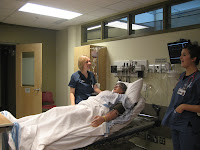The stories concerning Cockpit (Crew) Resource Management (CRM) in aviation and health care in Vicente’s “Staying on the Same Page” are so interesting, readable and remarkable. These vivid CRM success stories strongly show us the importance of designing the technological systems to fit people working at a team level. In return, how crucial the effective Human-tech systems play a role to improve team collaboration! Moreover, from designer’s perspective, these CRM examples enlighten us how to create effective Human-tech systems that foster team collaboration.
Last year, I once coincidently visited the alike simulation rooms for undergraduate nursing students, which were then located in the professional building at the U of C (See the right picture). The settings I saw in those rooms were fabulously similar as what Vicente described in his book. My eyes were cheated by the dummy lying on the bed in the simulated ward. I took it for granted that “she” should be a real patient until I was close to the bed then I realized how incredible it was. I only thought this kind of simulation was for students’ health care skills practice, but I had never considered it as one of the functionalities to improve team collaboration capability.
How many times have you noticed and complained that the more people work on the same thing, the worse result it gets. Just as Norman (2005) mentioned that “the more people that check on something, the less carefully each person performs the task.” (p145) Not only Vicente but Norman emphasize the great role of CRM on decreasing the problems that raised in team collaboration, though their elaborations are a little bit different. Both of their thoughts are based on human factors—crew members’ psychology and characteristic, more specifically, the CRM system’s target users’ characteristics.
Users’ characteristics—these “softer” factors are more likely to be ignored by designers, but interestingly, they are also the invisible criteria to evaluate how the design or product is, sometimes, it indirectly results in whether the thing assisted by the design succeed or not. Both Norman and Vicente have examined a lot about how effective Human-tech systems benefit us. That is why user’s characteristics, as a very important human factor, we should usually keep it in mind when creating and developing our design.
Once again, Vicente’s (2006) Chapter 6 deepens my understanding on the connotation of user-centered design. No matter how sophisticated it is, designers should try to help people “stay on the same page” by design (p180), furthermore, to satisfy our human or societal needs by tailoring the design of the system to fit human realities (p163).


No comments:
Post a Comment